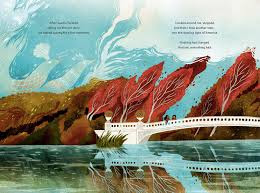"It was a brilliant idea. The alligator
fell fast asleep, and the boy used his
pocketknife to cut the twisty vine. Then
he ran home as fast as he could."
What fun this is! I have been asked to do a ZOOM read for a school in a couple of weeks. At this moment, this is sure to be one of the books I read for the kids there. I will just have to practise my 'alligator lullaby'.
A young boy who lives on the outskirts of town and loves to walk in the woods near his home is surprised to find an alligator in his path one warm day. His first reaction is one of fear - just as anyone meeting an alligator would feel. It takes no time to realize the alligator is caught in a vine. The boy offers food, in case the alligator is hungry. One tuna fish sandwich will not fill the void. He runs home for more. The menu is varied and acceptable, but for the onion. Even the food bag is devoured.
The next problem presented is how to get close enough to cut the vine. Might a lullaby do the trick? After a satisfying lunch, and some soothing music, the alligator succumbs to sleep. The boy cuts the vine, and quickly makes tracks away from the resting reptile. That night, the alligator shows up at his house.
Together they share happy days; dancing, reading, riding, and bathing, . Then, the boy decides to take his new friend to town. Oh, dear! The townsfolk are terrified, resulting in the mayor making a proclamation against alligators. The boy explains that the alligator could play an important role in town life - he can eat up all of their leftovers. The townspeople see the wisdom of the argument, the mayor does not. It is left to the alligator itself to find ways to avoid the mayor's surveillance. When it becomes too big, the people in town work with the boy to tackle the problem. Huzzah!
Andrea Stegmaier's pencil artwork is colored digitally. Her humor and poignancy add depth to the tale, while enhancing every scene. There is such joy in her images, and the extra details she creates to add further meaning to a well-told story. Readers will pore over every scene as they read this book repeatedly.
























































